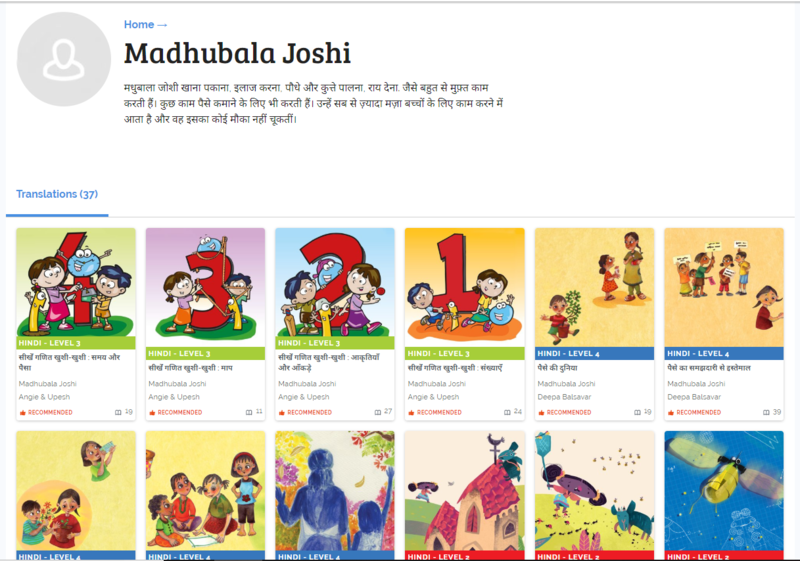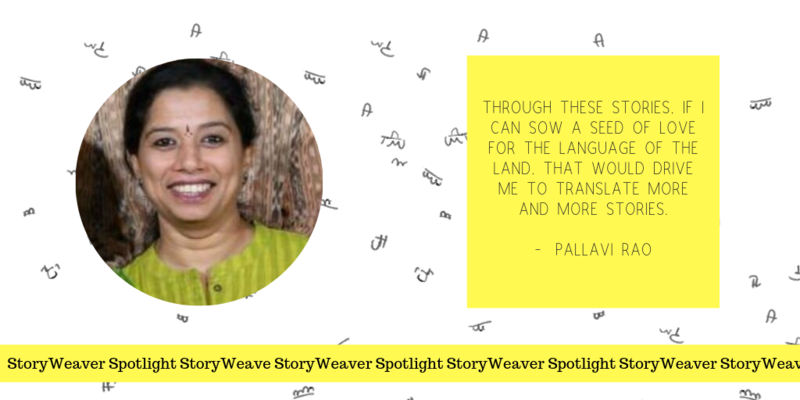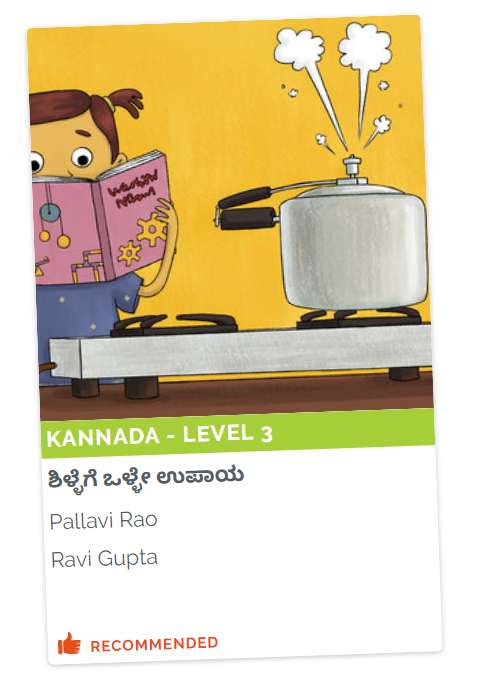ಪುಟ್ಟಿ ಮತ್ತು ಪುಸ್ತಕಗಳು/ Putti and Books
Posted by Remya Padmadas on October 09, 2019"Translations are equivalent to communicating science" opines Kollegala Sharma, Science Communicator, Senior principal scientist at CFTRI. Translations are just like reciting stories. Stories are an effective source of learning, given their vast scope and structure. Science itself is a type of language, and so science communication and translation for kids face similar challenges. Below is a short story in Kannada about two sisters. Putti is a young girl who is curious to know things that she sees around her. When she sees a picture book, she is curious about mammals like the platypus, but her sister finds it difficult to explain this to Putti as these words are unfamiliar to the toddler’s experience and environment. The story depicts the difficulties of translating science concepts.
ಅನುವಾದ ಅನ್ನುವುದು ಹೀಗೇ. ಮಕ್ಕಳಿಗೆ ಕಥೆ ಹೇಳಿದ ಹಾಗೆ. ಅವರಿಗೆ ತಿಳಿಯದ್ದನ್ನು ತಿಳಿಸುವ ರೀತಿಯಲ್ಲೇ, ಬೇರೆ ಬಾಷೆಯದ್ದನ್ನೂ ನಮ್ಮ ಓದುಗರಿಗೆ ತಿಳಿಸಬೇಕಾಗುತ್ತದೆ. ವಿಜ್ಞಾನವೂ ಬೇರೆ ಭಾಷೆಯೇ ಆಗಿದ್ದರಿಂದ ಇದೇ ಕಥೆ ಅಲ್ಲಿಯೂ ಸಲ್ಲುತ್ತದೆ.
ಧೊಪ್…
“ಏನೇ ಅದು ಸದ್ದು?” ಅಮ್ಮ ಅಡಿಗೆ ಮನೆಯಿಂದಲೇ ಕೂಗಿದಳು
ಅಯ್ಯೋ. ಇನ್ನು ಅಕ್ಕ, ಅಮ್ಮ ಇಬ್ಬರೂ ಬರುತ್ತಾರೆ. ಅಷ್ಟರಲ್ಲಿ ಇದೆಲ್ಲ ಸರಿ ಮಾಡಬೇಕು. ಪುಟ್ಟಿ ಕೆಳಗೆ ಬಿದ್ದ ಚೀಲವನ್ನು ನೋಡಿದಳು.
ಅಯ್ಯೋ. ಇದರಲ್ಲಿ ಚಾಕಲೇಟು ಇಲ್ಲ. ಬರೀ ಪುಸ್ತಕ.
ಶಾಲೆಯಿಂದ ಬಂದ ಅಕ್ಕ ಚೀಲವನ್ನು ಬಿಸಾಡದೆ ಮೇಜಿನ ಮೇಲೆ ಇಟ್ಟಳಲ್ಲ. ಆಗಲೇ ಅದರಲ್ಲೇನೋ ಗುಟ್ಟು ಇರಬೇಕು ಅಂತ ಪುಟ್ಟಿಗೆ ಅನಿಸಿತ್ತು. ಯಾರಾದರೂ ಹುಟ್ಟಿದ ಹಬ್ಬಕ್ಕೆ ಕೊಟ್ಟ ಚಾಕಲೇಟು ಇರಬಹುದು ಅಂದುಕೊಂಡಿದ್ದಳು. ಆದರೆ…
“ಓಹೋ. ಎಷ್ಟೊಂದು ಪುಸ್ತಕ. ಎಷ್ಟೊಂದು ಬಣ್ಣ.”
“ಏಯ್ ಪುಟ್ಟಿ. ಅದು ನಂದು ಪುಸ್ತಕ. ಮುಟ್ಟಬೇಡ.” ಬೆನ್ನ ಹಿಂದಿನಿಂದ ಅಕ್ಕ ಹೇಳಿದಳು.
“ಪುಟ್ಟಿ. ಅಕ್ಕನ ಚೀಲ ಮುಟ್ಟಬೇಡ ಅಂತ ಹೇಳಿದ್ದೆ. ಮೈ ಮೇಲೆ ಬಿದ್ದಿದ್ದರೆ?ʼ ಅಮ್ಮ ಕೂಡ ಬೈದಳು.
“ಅಕ್ಕ, ಅಕ್ಕ. ಪುಸ್ತಕ ಕೊಡೇ? ನಾನೂ ನೋಡ್ತೀನಿ.”
“ಏಯ್ ಹೋಗೇ. ನಿಂಗೆ ಓದಕ್ಕೆ ಬರೆಯಕ್ಕೆ ಬರತ್ತಾ? ದೊಡ್ಡವಳಾಗು ಆಮೇಲೆ ಕೊಡ್ತೀನಿ.”
ಈ ದೊಡ್ಡವರೆಲ್ಲ ಹೀಗೇ. ದೊಡ್ಡವರಷ್ಟೆ ಪುಸ್ತಕ ಓದಬಹುದು ಅಂದುಕೊಂಡಿದ್ದಾರೆ. ನಂಗೆ ಅಕ್ಷರ ಗೊತ್ತಿಲ್ಲದಿದ್ದರೆ ಏನಂತೆ? ಈ ಬಣ್ಣ, ಬಣ್ಣದ ಚಿತ್ರ ನೋಡಬಹುದು.
“ಅಕ್ಕ. ಚಿತ್ರ ನೋಡ್ತೀನಿ ಕೊಡೇ?”
“ಬೇಡ ಪುಟ್ಟಿ. ಅದು ಶಾಲೆಯ ಪುಸ್ತಕ. ಆಮೇಲೆ ನೀನು ಹರಿದು ಹಾಕಿದರೆ. ದೊಡ್ಡವಳಾದ ಮೇಲೆ ನಿಂಗೂ ಇವೆಲ್ಲ ಸಿಗುತ್ತೆ.” ಈಗ ಅಮ್ಮನ ಸರದಿ.
“ಪರವಾಗಿಲ್ಲ ಅಮ್ಮ. ನಾನು ಬರೇ ಚಿತ್ರ ನೋಡ್ತೀನಿ.”
“ಹೋಗೇ. ಹೋಗೇ. ಅದು ಇಂಗ್ಲೀಷು ಬುಕ್ಕು! ಇದು ದೊಡ್ಡ ಮಕ್ಕಳ ಪುಸ್ತಕ ಗೊತ್ತಾ? ನಿಂಗೆ ಅರ್ಥ ಆಗಲ್ಲ.”
“ಇಲ್ಲ ಅಕ್ಕ. ನೋಡು. ಇದು ನಾಯಿ. ಇದು ಮಂಚ. ನಾಯಿ ಮಂಚದ ಕೆಳಗೆ ಏನನ್ನೋ ಹುಡುಕುತ್ತಾ ಇದೆ. ಅಲ್ಲವಾ? ನೋಡಿದ್ಯಾ?”
“ಓಹೋಹೋಹೋ. ಓದಕ್ಕೆ ಬರತ್ತಂತೆ. ನಾಯಿ, ಮಂಚ ಸರಿ. ಇದು ಏನು ಹೇಳ್ತೀಯಾ?”
“ಯಾವುದು? ಇದಾ?... ಇದು… ಇದು…”
“ನೋಡು. ನೀನು ಇನ್ನೂ ಚಿಕ್ಕವಳು. ಚಿತ್ರ ನೋಡಕ್ಕೂ ಬರಲ್ಲ.”
“ಇಲ್ಲ ಅಕ್ಕ. ಅದು ಏನೋ ನಾನು ನೋಡಿಲ್ಲ. ಅದು ಏನದು ಅಕ್ಕಾ?ʼ
“ನಾನೂ ನೋಡಿಲ್ಲ. ಆದರೆ ಅದು ಏನು ಅಂತ ನಂಗೆ ಗೊತ್ತು. ಅದಿಕ್ಕೆ ಹೇಳಿದ್ದು ನೀನು ದೊಡ್ಡವಳಾಗಬೇಕು ಅಂತ.”
“ನೀನೂ ನೋಡಿಲ್ಲವಾ? ಮತ್ತೆ ಅದು ಹೆಂಗೆ ನಿಂಗೆ ಗೊತ್ತಾಯಿತು? ಏನದು?”
“ಅದು ಪ್ಲಾಟಿಪಸ್ ಅಂತ. ನಮ್ಮ ಟೀಚರ್ರು ಅದರ ಬಗ್ಗೆ ಹೇಳಿಕೊಟ್ಟಿದ್ದರು.”
“ಓ. ನಾನು ನಾಯಿ ಅಂದುಕೊಂಡಿದ್ದೆ. ಈಗೇನಂತೆ. ಪ್ಲಾಟಿಪಸ್ ಅಂತ ಹೆಸರು ಅಷ್ಟೆ ತಾನೇ. ಆದರೆ ಅದು ಈಗ ಮಂಚದ ಕೆಳಗೇ ಇದೆಯಲ್ಲ.”
“ಆದರೂ ಪ್ಲಾಟಿಪಸ್ಸೇ ಬೇರೆ, ನಾಯೀನೇ ಬೇರೆ ಗೊತ್ತಾ?, ಅಕ್ಕ ಹೇಳಿದಳು.
“ಅದೇನೋ. ಎರಡೂ ಪ್ರಾಣಿಗಳು ಅಷ್ಟೆ.” ಎಂದಳು ಪುಟ್ಟಿ.
ಹಂಗೆಲ್ಲ ಗೊತ್ತಿಲ್ಲದ ವಿಷಯ ಓದೋದು ಕಷ್ಟ ಗೊತ್ತಾ? ಅದಿಕ್ಕೆ ಮೊನ್ನೆ ನಮ್ಮ ಟೀಚರ್ರು ಬೈದಿದ್ದರು.”
“ಟೀಚರ್ರು ಬೈದರಾ? ಯಾಕೆ? ನೀನೇನು ಮಾಡಿದೆ?” ಅಮ್ಮ ಅಕ್ಕನನ್ನು ಕೇಳಿದರು.
“ಏನಿಲ್ಲ. ಪ್ಲಾಟಿಪಸ್ ಹೆಸರನ್ನ ಬರಿ ಅಂತ ಡಿಕ್ಟೇಶನ್ ಕೊಟ್ಟಿದ್ದರು. ನಾನು ತಪ್ಪಾಗಿ ಬರೆದಿದ್ದೆ.”
“ಯಾಕೆ? ಅವತ್ತು ನಾನೂ ಹೇಳಿಕೊಟ್ಟಿದ್ದೆನಲ್ಲ? ಮರೆತು ಹೋಯಿತಾ?” ಅಮ್ಮ ಕೇಳಿದರು.
“ಇಲ್ಲಮ್ಮ. ಮರೀಲಿಲ್ಲ. ಇಂಗ್ಲೀಷಲ್ಲಿ ಚೆನ್ನಾಗಿ ಗೊತ್ತು. ಪಿ ಎಲ್ ಎ ಟಿ ವೈ ಪಿ ಯು ಎಸ್ ಅಂತ. ಆದರೆ ಕನ್ನಡದಲ್ಲಿ ಬರಿ ಅಂದರು. ಬರೆದಿದ್ದು ತಪ್ಪು ಅಂದರು.”
“ಓಹೋ. ಸರಿ ಬಿಡು. ನಿಂಗೆ ಒತ್ತಕ್ಷರ ಇನ್ನೂ ಕಲಿಸಿಲ್ಲ. ಅದು ಹೇಗೆ ಅದನ್ನ ಬರೆಯಕ್ಕೆ ಆಗತ್ತೆ?” ಅಮ್ಮ ಹೇಳಿದರು.
“ಅಲ್ಲಮ್ಮ. ಅಕ್ಕ ಇಂಗ್ಲೀಷಲ್ಲಿ ಬರೀತಾಳೆ. ಕನ್ನಡದಲ್ಲಿ ಯಾಕೆ ತಪ್ಪು ಮಾಡ್ತಾಳೆ?”
“ಪುಟ್ಟಿ ಅದೆಲ್ಲ ಗೊತ್ತಾಗಕ್ಕೆ ನೀನು ದೊಡ್ಡವಳಾಗಬೇಕು. ಕನ್ನಡದಲ್ಲಿ ಸ್ಪೆಲ್ಲಿಂಗು ಸ್ವಲ್ಪ ಕಷ್ಟ. ಇಂಗ್ಲೀಷಲ್ಲಿ ಹಾಗಲ್ಲ. ಅದಿಕ್ಕೆ ಇಂಗ್ಲೀಷು ಹೆಸರನ್ನ ಕನ್ನಡದಲ್ಲಿ ಬರೆಯೋದು ಕಷ್ಟ. “
“ಅಕ್ಕಾ ಅಕ್ಕಾ. ನಿಂಗೆ ಈ ಪುಸ್ತಕ ಓದಕ್ಕೆ ಬರತ್ತೆ ಅಲ್ಲವಾ? ನೀನೇ ಓದಿ ನಂಗೆ ಕಥೆ ಹೇಳ್ತೀಯಾ?”
“ಓ ಅದಕ್ಕೇನಂತೆ? ಹೇಳ್ತೀನಿ.” ಅಡ್ವೆಂಚರ್ಸ್ ಆಫ್ ಮಿರಿಂಡಾ – ದಿ ಪ್ಲಾಟಿಪಸ್.
“ಏಯ್ ಅಕ್ಕ. ನಂಗೆ ಅರ್ಥ ಆಗ್ಲಿಲ್ಲ. ಕನ್ನಡದಲ್ಲಿ ಹೇಳೇ?
“ಅದು ಹೇಗೆ ಹೇಳಲೇ ಪುಟ್ಟಿ. ಇದು ಇಂಗ್ಲೀಷು ಪುಸ್ತಕ.”
“ಅಕ್ಕ. ನೀನು ಓದಿದ್ದೀಯಲ್ಲ. ನಿಂಗೆ ಕಥೆ ಗೊತ್ತಿರತ್ತೆ. ಅದನ್ನೇ ಹೇಳೇ?
“ಏಯ್ ಹೋಗೇ. ಅದೇನು ಅಷ್ಟೊಂದು ಸುಲಭ ಅಂದುಕೊಂಡಿದ್ದೀಯಾ?”
“ ಅಕ್ಕ. ಪ್ಲೀಸ್ ಹೇಳೇ! ಯಾಕೆ ನಿಂಗೂ ಅರ್ಥ ಆಗಿಲ್ಲವಾ?”
“ಓ. ನಂಗೆ ಅರ್ಥ ಆಗಿದೆ. ಆದರೆ ಇದು ಇಂಗ್ಲೀಷು ಅಲ್ಲವಾ ನಿಂಗೆ ಗೊತ್ತಾಗಲ್ಲ ಅಂದೆ ಅಷ್ಟೆ. ಸರಿ ಹೇಳ್ತೀನಿ ಕೇಳು. ಇದು ಮಿರಿಂಡಾ ದಿ ಪ್ಲಾಟಿಪಸ್ಸಿನ ಸಾಹಸಗಳು.”
“ಮಿರಿಂಡಾ, ಪ್ಲಾಟಿಪಸ್ಸು, ಅದನ್ನೂ ಇಂಗ್ಲೀಷಲ್ಲಿ ಹೇಳಕ್ಕಾ?”
“ಅಯ್ಯೋ. ಅದು ಹೆಸರು ಕಣೇ. ಅವನ್ನ ಇಂಗ್ಲಿಷಲ್ಲಿ ಹೇಗೆ ಹೇಳೋದು?”
“ಸರಿ. ಆಮೇಲೆ?.”
“ಮಿರಿಂಡಾ ಒಂದು ಪ್ಲಾಟಿಪಸ್ಸು. ಪ್ಲಾಟಿಪಸ್ಸು ಅಂದರೆ ಗೊತ್ತಲ್ಲಾ? ಅದು ಒಂದು ಮ್ಯಾಮಲ್?”
“ಮ್ಯಾಮಲ್? ಹಂಗಂದ್ರೆ?ʼ
“ಹಂಗಂದ್ರೆ. ಹಂಗಂದ್ರೆ.. ಹಂಗಂದ್ರೆ… “
“ಅಕ್ಕಂಗೂ ಗೊತ್ತಿಲ್ಲ. ಅಕ್ಕಂಗೂ ಗೊತ್ತಿಲ್ಲ.”
“ಏಯ್. ಸುಮ್ನಿರೇ. ಗೊತ್ತಿಲ್ಲ ಅಂತಲ್ಲ. ಕನ್ನಡದಲ್ಲಿ ಏನಂತಾರೆ ಗೊತ್ತಿಲ್ಲ. ಮ್ಯಾಮಲ್ ಅಂದರೆ ಹಾಲು ಕುಡಿಸೋ ಪ್ರಾಣಿಗಳು ಅಂತ ನಮ್ಮ ಟೀಚರ್ರು ಹೇಳಿಕೊಟ್ಟಿದ್ದಾರೆ ಗೊತ್ತಾ?.. ಇರು ಅಮ್ಮನ್ನ ಕೇಳ್ತೀನಿ. ಅಮ್ಮಾ. ಅಮ್ಮ. ಮ್ಯಾಮಲ್ ಅಂದರೆ ಏನಮ್ಮಾ? ಅದೂ ಹೆಸರಾ?”
“ಮ್ಯಾಮಲ್ಲು ಅಂದರೆ ಸ್ತನಿ ಅಂತ ಮಗಳೇ. ಅದು ಗುಂಪಿನ ಹೆಸರು. “
“ಮತ್ತೆ ಹೆಸರನ್ನು ಹಾಗೇ ಇಡಬೇಕಲ್ಲವಾ?”
“ಇದು ಹೆಸರು ನಿಜ. ಆದರೆ ಇದು ಒಂದು ಗುಂಪಿನ ಹೆಸರು. ಇಂಥವರದ್ದು ಅಂತ ಇಲ್ಲ. ಅದಿಕ್ಕೆ ಇದನ್ನ ನಾವು ಕನ್ನಡದಲ್ಲಿ ಬೇರೆ ಹೆಸರಿಟ್ಟು ಕರೀಬಹುದು. ಸ್ತನಿ ಅಂತ ಅದಕ್ಕೆ ಹೇಳ್ತೀವಿ.”
“ಓಹೋ. ಗೊತ್ತಾಯಿತು.”
“ಸರಿ. ಪ್ಲಾಟಿಪಸ್ ಒಂದು ಸ್ತನಿ. ಅದು ಮೊಟ್ಟೆ ಇಡುತ್ತದೆ.”
“ಹೂಂ. ಗೊತ್ತಾಯಿತು. ಅದು ಈಗ ಏನನ್ನೋ ತಿನ್ನಕ್ಕೆ ಹೋಗ್ತಾ ಇದೆ ಅಲ್ಲವಾ?”
“ಪುಟ್ಟಿ. ಜಾಣೆ ಕಣೆ. ಅದು ಹೆಂಗೇ ಗೊತ್ತಾಯಿತು?”
“ಅಯ್ಯೋ ಅಕ್ಕಾ. ಈ ಚಿತ್ರ ನೋಡು. ಪಲಾಟಿಸ್ಸು ಆ ಪಾತ್ರೆ ಕಡೇನೇ ನೋಡ್ತಾ ಇದೆ. ಆ ಪಾತ್ರೇಲಿ ತಿಂಡಿ ಇದೆ ಅಲ್ಲವಾ?”
“ಪುಟ್ಟಿ. ಅದು ಪಲಾಟಿಸ್ಸು ಅಲ್ಲ. ಪ್ಲಾಟಿಪಸ್ಸು. ಆ ಪಾತ್ರೇಲಿ ಇರೋದು ಚೀಸು”
“ಪ..ಪಪ..ಪಲಾಆಆಆಟಿಪಸ್ಸು… ಸರೀನಾ… ಇಂಗ್ಲೀಷಲ್ಲಿ ಯಾಕಪ್ಪ ಅಷ್ಟೊಂದು ಕಷ್ಟದ ಹೆಸರು ಇಡ್ತಾರೆ.”
“ಪುಟ್ಟಿ. ಹೆಸರು ಕಷ್ಟ ಅಲ್ಲ. ನಿಂಗೆ ಓದಕ್ಕೆ ಬರಲ್ಲ. ನೋಡು ನಾನು ಓದಲ್ಲವಾ?”
“ಹೋಗಕ್ಕ. ನೀನು ದೊಡ್ಡವಳು. ಆಮೇಲೆ ಆ ಚೀಸು ಬೆಣ್ಣೇನಾ?”
“ಅಯ್ಯೋ ಪೆದ್ದಿ. ಚೀಸು ಬೆಣ್ಣೆ ಅಲ್ಲ. ಅದು ಚೀಸು.”
“ಆದ್ರೆ ಬೆಣ್ಣೆನೂ ಹಾಗೇ ಹಳದೀಗೆ ಇರುತ್ತೆ ಅಲ್ಲವಾ?”
“ಹೋಗೆ ಪೆದ್ದಿ. ನಿಂಗೆ ಏನೂ ಹೇಳಿಕೊಡಲ್ಲ. ಸುಮ್ಮನೆ ಪ್ರಶ್ನೆ ಕೇಳ್ತಾ ಇರ್ತೀಯಾ? ಅದು ಇಂಗ್ಲೀಷು ತಿಂಡಿ. ಅದನ್ನ ಚೀಸು ಅಂತಾರೆ. ಅದು ಬೆಣ್ಣೆ ಅಲ್ಲ.”
“ಊಊಊ… ಅಮ್ಮ. ಅಮ್ಮ. ಅಕ್ಕ ಪೆದ್ದಿ ಅಂದಳು.” ಪುಟ್ಟಿ ಅಳುತ್ತಾ ಓಡಿದಳು.
Do join the conversation by leaving your thoughts in the comments section below. You can also reach out to us through our social media channels: Facebook, Twitter and Instagram.
Be the first to comment.हर नया अनुवाद भाषा के क्षितिज को कुछ आगे सरकाता है
Posted by Remya Padmadas on October 04, 2019Madhu B. Joshi prefers to be known as a communication practitioner. She sees a great need for demystification in daily life and has been trying to work towards it. She has taught translation and a short, self-designed course of Indian culture, mentored content teams of major education NGOs and designed educational audio-video programmes for CIET and NCERT. Joshi is a translator of Hindi poetry and short fiction in English and has presented major black feminist writers in Hindi. She is also a prolific and visionary collaborator of StoryWeaver, and has translated many storybooks into Hindi including मुझे खोज कर दिखाओ! and बाग की सैर. You can read all her stories on StoryWeaver here.
Apart from all of the above, we also know and love the other मधु बी. जोशी (in her own words)... जो खाना पकाना, इलाज करना, पौधे और कुत्ते पालना, राय देना.. जैसे बहुत से मुफ़्त काम करती हैं। उन्हें सब से ज़्यादा मज़ा बच्चों के लिए काम करने में आता है और वह इसका कोई मौका नहीं चूकतीं।
In this blog post, Joshi writes about the complexity of translation and the many challenges it presents.

Stories translated into Hindi by Madhu B. Joshi on StoryWeaver.
स्टोरीवीवर की कहानियों का अनुवाद हमेशा चुनौती साथ लाता हैः हमें ठीक-ठीक मालूम नहीं होता कि कहानी का पाठक दुनिया के किस हिस्से में है, उसकी आयु या शैक्षणिक पृष्ठभूमि क्या है, वह प्रस्तुत पाठ को किस उद्देश्य से पढ़ रही है, क्या हमारे शब्द उसके लिए भी वही अर्थ रखते हैं, क्या हमारा किया अर्थान्वय उसके लिए भी कारगर रहेगा?.....अनेक प्रश्न बार-बार कलम रोकते हैं। और फिर लेखक के मूल कथ्य और मंतव्य को पकड़ने की चुनौती तो हमेशा ही अनुवादकों के सामने रहती है-अरे मन संम्हल-सम्हल पग धरिये!
एक मोटा-मोटा सूत्र राह दिखाता हैः अनूदित सामग्री पढ़नेवाले पाठक के लिए वही मूल रचना है। लेकिन नामों और रिश्तों का जटिल संसार कभी-कभी बहुत कड़ी परीक्षा लेता है। एक कहानी में दक्षिण भारतीय मुख्य चरित्र, जो एक लड़का था, का नाम सत्या था, हिंदी मे यह लड़कियों का नाम होता है; तो नामों के मूल रूप बनाए रखने की ताकीद के बावजूद मैंने उसका नाम सत्य कर दिया क्योंकि मुझे हिंदी के पाठकों को भ्रम में न डालना ज़्यादा महत्वपूर्ण लगा। हाल ही में गोआनी मूल के ईसाई लेखक की लिखी सुंदर और बहुत रोचक कविता-कहानी में शवयात्रा के समय बजनेवाले बैंड (भारत में कम ही जगह इस तरह का चलन है) का उल्लेख आया। इसे हिंदी के बाल-पाठक को समझाने के लिए हमें लंबी-चैड़ी टिप्पणी देनी पड़ती जो पढ़ने का मज़ा ही किरकिरा कर देती। तो हल निकाला शवयात्रा का उल्लेख गोल करके; पाठ की रोचकता बरकार रही, उस की गुणवत्ता हल्की नहीं हुई।
लेकिन कई बार तकनीकी शब्दावली की यांत्रिकता आड़े आती हैः प्रचलित शब्द गोल/गोला से पता नहीं चलता कि वह किसी पिंड का संकेत दे रहा है या द्विआयामी आकृति काः गेंद भी गोल है, और नंगी आंख से धरती से दिखता चांद भी! अब अगर हम सायकिल के पिंडाकार पहियों की बात कहना चाहें तो कैसे कहेंगे? एक और बड़ी समस्या पशु-पक्षियों-कीट-पतंगों-वनस्पतियों के नाम हिंदी में बताते हुए आती है। इस संदर्भ में ‘ताल का जादू’ के हिंदी अनुवाद की याद आती है। इसमें उल्लिखित कई पक्षियों और कीटों के नाम मुझे नहीं पता थे। हमारी प्रचलित शब्दावली में, कई कारणों से इन में से बहुत के नाम उपलब्ध नहीं हैं; किसी वैज्ञानिक शब्दावली में मिल भी जाएं तो शेर-बाघ-तेंदुए के बीच अंतर न जानने वाले हमारे पाठकों के लिए वे इतने अपरिचित होते हैं कि अंग्रेज़ी नाम देना भी ठीक ही लगता है-जैगुआर कहने पर यह संभावना बनी रहेगी कि कोई जानकार उसे इसका अर्थ समझा सकता है (वैसे जैगुआर अमेरिका में पाए जाने वाले तेंदुए हैं)। बेसिल का अर्थ आमतौर पर तुलसी लगाया जाता है लेकिन तुलसियां भी कम से कम छः तरह की होती हैं, बेसिल में यह तथ्य निहित है, तुलसी में नहीं।
हर नया पाठ अनुवादक के लिए नई चुनौती लाता है। हर नया अनुवाद भाषा के क्षितिज को कुछ आगे सरकाता है।
We'd love you to join the conversation by letting us know your thoughts in the comments section below.
For more updates, follow us on social media: Facebook, Twitter,Instagram.
Be the first to comment.StoryWeaver Spotlight: Pallavi Rao
Posted by Remya Padmadas on October 04, 2019Pallavi Rao has done her MA in English and loves music, literature and painting. She is the daughter of well-known Kannada writer Vaidehi, and has worked on a compilation of talks by eminent theatre personality Sri B.V Karanth (edited by Sri Muralidhar Upadhya). Pallavi has been teaching PU students in several places and currently resides in Delhi. She has translated several storybooks to Kannada including The Night the Moon Went Missing and A Whistling Good Idea on StoryWeaver.

Q: You carve out time for translating children’s books from a busy life. What do stories in translation bring to young readers?
Young readers unknowingly come to know the culture, way of life and language at a young age itself. I think it is very important to imbibe these qualities at a young age.
Q: What is your personal relationship to language and/or translation?
Kannada being my mother tongue, I have read and listened to several great writers and thinkers in Kannada. I breathe my language and this helps me bring stories into Kannada.
Q: What is your take on translation?
Translation is a very responsible task. You have to translate the story keeping its original flavour intact and at the same time giving it the flavor of the language it is translated into. One should have a grip on both the languages i.e., from which you are translating and the one to which it is being translated into.
Q: Translating certain stories must have required a lot of research, especially when it came to STEM-related terms and concepts. For example, stories like A Whistling Good Idea. How did you explore new objects and concepts?
When I read a story to be translated, I dwell on it and begin thinking it in my language. It helps me to understand the story in local circumstances so that I can translate accordingly. While translating concept-oriented stories like ‘A Whistling Good Idea’, I felt it was such a nice way to make a child understand the concept in a playful manner. Difficult concepts are quite hard for children, but when the same concept is told through games, it becomes simple and hence is more understandable and easy for a child.

'A Whistling Good Idea', translated by Pallavi Rao
Q: You have contributed for us immensely. How has the StoryWeaver journey been? What is one big takeaway from this experience?
Overwhelming. By repeatedly wearing a child’s shoe while translating, it has made me more observant and my mind keeps weaving stories for children from whatever I observe around me!
Q: How do you feel when your story reaches the child?
If I can ignite the imagination of a child and add to the child’s vocabulary through my stories, nothing would be more satisfying.
Q: What is your key driver in taking up translation of stories into Kannada?
I have a very strong feeling towards my language. Children in big cities in my state rarely speak Kannada, which is very disturbing. Through these stories, if I can sow seed of love for the language of the land - that would drive me to translate more and more stories.
Q: How else do you think we can join hands to take more stories to more children in more languages?
India has abundant folk stories and poems for children in regional languages. They have to be made reachable to more children in other languages too. For example, in Kannada, we have stories of Panje Magesh Rao, Hoysala, Ullala Mangesh Rao, Ugrana Mangesh Rao, Rajaratnam and so on. Apart from translating stories from English to regional languages, I feel that we should also translate stories from regional languages to English and to other regional languages as well.
Q: When you have been given a story to translate, what is your process, and how long does it generally take?
I read the entire story two or three times, linger on the story and try to visualize the same while working on other chores. I try to keep the language simple, use more of sound words to make it more attractive and increase the vocabulary in children.
Q: What is the hardest thing about translating from English into Kannada? How do you navigate words or phrases that are tricky to translate?
Certain English concepts are not present in Kannada. For example, we don’t have a ‘cape’ in our costume. In such times we have to coin a word in Kannada and ensure that the image is translated successfully to the child.
Q: Do you have any advice for anyone interested in becoming a translator?
Keep the language as simple as possible and make it interesting for children by visualising the story yourself to get the best output.
Q: A book you'd like to recommend to other translators?
From the ones that I have translated it would be ‘A Whistling Good Idea’.
Q: Can you tell us anything about yourself and your job that would surprise us?
Cooking and painting interests me to a large extent. Experimenting techniques in both the fields are the same, I feel.
We would love for you to join the conversation by leaving your thoughts in the comments section, or on social media: Facebook, Twitter, Instagram
Be the first to comment.